
S.Warren. Designing organic syntheses
..pdf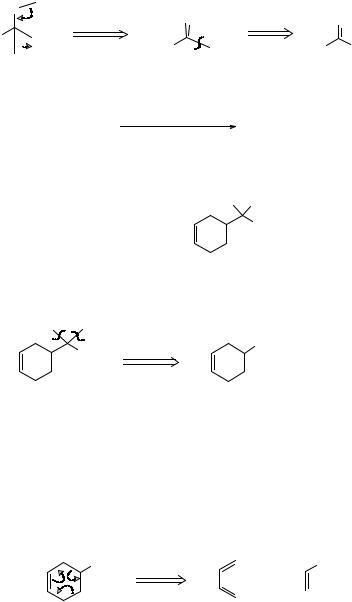
8
Both have reasonable mechanisms, but we prefer (b) because it introduces more simplification. Route (a) simply chops off one carbon atom and leaves us with a new target almost as difficult to make as TM 16. Route (b) however breaks the molecule into two more equal pieces -acetone and cyclohexyl bromide.
We now have two criteria for a good disconnection: we look for (a) a good mechanism and (b) the greatest simplification.
_______________________________________
l8. An alternative approach to this problem, providing two of the groups on the tertiary alcohol are the same, is to remove both in a single disconnection going back to an ester and two mols of the Grignard reagent:
H
O
Ph  Et
Et
Et
and the reaction is
PhCO2R
How would you make TM 18?
|
O |
|
O |
Ph |
|
|
+ 2 EtMgBr |
Et |
Ph |
OR |
2 EtMgBr
PhC(Et)2OH
Ph Ph
OH
TM 18
_______________________________________
19.
Ph Ph
CO2Et
OH
+ 2 PhMgBr
TM 19
Can you continue one stage further back from TM 19?
_______________________________________
20. TM 19 has a double bond in a six-membered ring and we can use the Diels-Alder disconnection (frames 5-8).
CO2Et |
CO2Et |
|
+ |
Note that the Diels-Alder reaction works best when there is an electron-withdrawing group (here CO2Et) on the olefinic component.
_______________________________________
21. If one of the groups in the alcohol carbon atom is H, then another disconnection is:
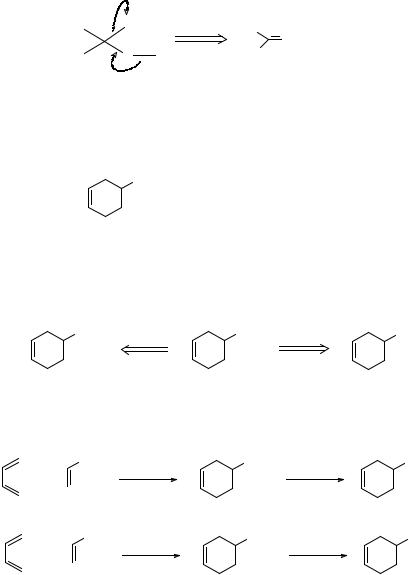
9
R |
H |
R |
O + H- |
|
|
||
R |
O H |
R |
|
The synthetic equivalents of the synthon H- are the hydride donors sodium borohydride NaBH4, and lithium aluminium hydride LiAIH4. How might you make TM 21 using this disconnection?
CH2OH
TM 21
_______________________________________
22. Remove either one or both hydrogen atoms:
CO2Et |
CH2OH |
CHO |
either starting material can again be made by a Diels-Alder reaction. The complete syntheses are then:
CHO |
CHO |
NaBH4 |
+ |
|
|
|
|
|
CO2Et |
CO2Et |
|
+ |
|
LiAlH4 |
|
|
CH2OH
CH2OH
Note that NaBH4 reduces aldehydes (and ketones) but not esters while LiAlH4 reduces just about all carbonyl compounds. Neither reagent reduces an isolated deuble bond.
_______________________________________
2. COMPOUNDS DERIVED FROM ALCOHOLS
23. Have you noticed that the disconnections involving H- are simply redox reactions and do not alter the carbon skeleton of the molecule? They are not then really disconnections at all but Functional Group Interconversions or FGI for short.
Alcohols are key functional groups in synthesis because their synthesis can be planned by an important disconnection and because they can be converted into a whole family of other functional groups. List three types of molecule you might make from an alcohol by FGI.
_______________________________________
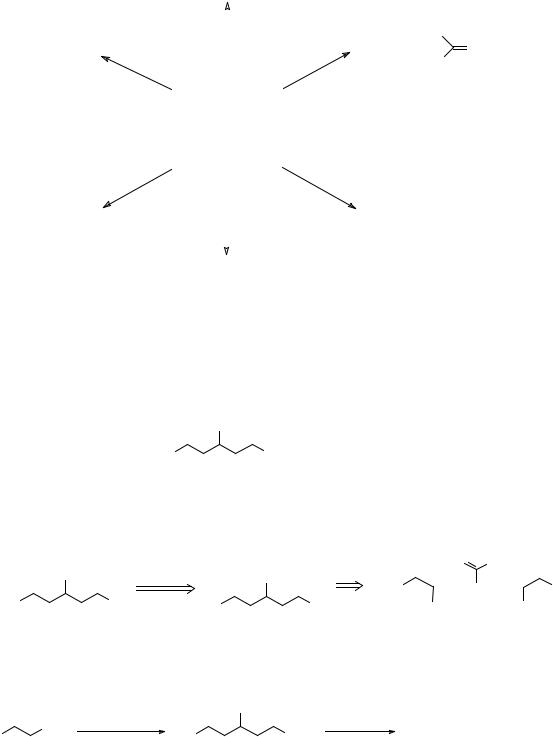
10
24. You might have chosen any from this chart: (there are others)
|
|
Alkyl |
Halides |
|
|
||
|
|
R - Hal |
|
|
|||
|
|
|
|
PHal3 |
Aldehyde Ketone |
||
|
|
|
|
||||
Ethers |
|
|
|
|
R1 |
||
|
|
|
or |
R ' CHO or |
|||
H+ |
|
O |
|||||
|
|
HHal |
|||||
ROR |
|
oxidation |
R2 |
||||
|
|
|
|
|
|
|
|
|
|
|
|
|
|
|
|
|
|
|
ROH |
|
|
|
|
|
|
Alcohol |
|
|
|
||
|
|
|
|
|
|
oxidation |
|
|
elimination |
|
|
|
|
||
|
|
|
|
|
|
||
Olefins |
reactions |
|
R ' COCl or |
Carboxylic Acid |
|||
|
|
|
( R ' CO )2O |
||||
see frames |
|
|
|
R ' CO2H |
|||
|
|
|
|
|
|||
36 - 43 |
|
|
|
|
|
|
|
Ether
RO . COR '
_______________________________________
25. These FGI's are mostly straightforward, and the synthesis of any of these compounds is often best analysed by first going back to the alcohol and then disconnecting that. How would you make TM 25?
|
OAc |
|
TM 25 |
Ph |
Ph |
_______________________________________
26. Analysis:
|
|
FGI |
|
|
O |
|
OEt |
|
OAc |
|
ester |
OH |
Ph |
+ |
H |
+ |
Ph |
|
|
|
|
|||||
Ph |
Ph |
|
|
|
||||
Ph |
Ph |
|
BrMg |
|
|
MgBr |
Synthesis:
|
|
1. Mg, Et2O |
OH |
Ac2O |
|
|
Br |
|
|||
Ph |
Ph |
Ph |
TM 25 |
||
|
|||||
|
pyridine |
||||
TM 26 |
|
2. HCO2Et |
|
||
|
|
|
|
_______________________________________
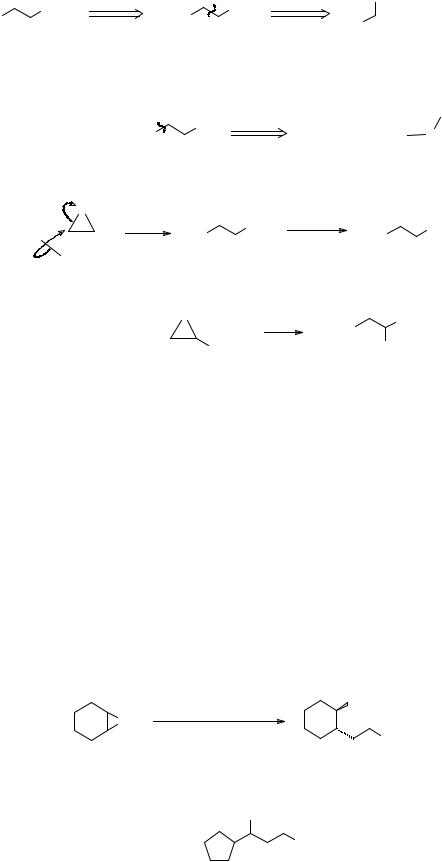
11
27. But let us analyse the synthesis of the halide (TM 26) a bit more. The obvious way to make it is:
FGI |
|
MgBr |
Br |
OH |
+ CH2O |
Ph |
Ph |
Ph |
|
|
Unfortunately this route gives only a 40% yield (J. Amer. Cham. Soc., 1951, 73, 3237) in the Grignard reaction, largely because benzyl Grignard reagents easily give radicals which
polymerise. In any case, it's poor tactics to chop off carbon atoms one at a time, and a better |
||||
disconnection would be: |
|
|
+ |
OH |
|
OH |
|
||
|
PhMgBr + |
|
||
|
Ph |
CH2 |
CH2 |
|
|
|
|
|
A |
The reagent for synthon A is an epoxide so that the reaction becomes: |
|
|||
O |
O- |
H2O |
|
|
Ph |
Ph |
OH |
||
Ph |
|
|
||
MgBr
This reaction works well with monosubstituted epoxides:
|
O |
R1 |
OH |
|
R1MgBr |
+ |
|||
|
||||
|
R2 |
|||
|
R2 |
|
but is unreliable if there are more substituents as you will see.
_______________________________________
3.REVIEW PROBLEMS
28.From time to time during the programme, I shall break off from introducing new ideas and help you consolidate what you've already learnt with some review problems. These are meant to be realistic problems showing why synthesis is important and should let you try out your growing skills. You can either do the review problems as you meet them or come back later and use them as revision material or combine both methods by doing one or two now and the rest later. These remarks apply to all the review problems and I won't repeat them each time.
_______________________________________
29.Review Problem 1: In 1936, Robinson carried out this reaction, hoping to get the alcohol A:
PhCH2CH2MgBr |
OH |
|
|
O |
|
|
Ph |
|
A |
He got an alcohol all right, but it clearly wasn't A, and he thought it might be TM 29.
OH
Ph
TM 29

12
He therefore wanted to synthesise TM 29 to check. Even with modern spectroscopic methods the quickest way to check the identity of a compound will often be to synthesise it by an unambiguous route and compare the n.m.r. and fingerprint i.r. spectra. How then would you make TM 29?
_______________________________________
30. Analysis: the obvious disconnection takes us back to the halide used by Robinson, the one we synthesised in frame 27:
|
OH |
|
|
|
|
a CH2OH |
|
Ph |
|
Ph |
CHO |
FGI |
|
|
BrMg |
+ |
|
|
||
|
|
|
|
|||
|
|
|
|
|
||
a |
|
MgBr |
|
|
|
|
|
|
+ CH2O |
|
|
|
|
This time the one-carbon disconnection a is all right because the Grignard reagent is from a normal alkyl halide and does not polymerise.
Synthesis:
OH
Br 1. Mg, Et2O |
HCl, CrO3 |
CHO |
2. CH2O |
pyr. |
|
62-64% |
|
78-92% |
MgBr
Ph
TM 29
"excellend yield"
TM 29, made by this route, did indeed turn out to be identical with the compound Robinson had made, and you might like to work out how it was formed. The reaction is discussed in Norman, p.501. The synthesis is described in J. Amer. Chem. Soc., 1926, 48, 1080; Tetrahedron Letters, 1975, 2647, and Robinson's original paper J. Cham. Soc., 1936, 80.
_______________________________________
31. Review Problem 2: This allyl bromide is an important intermediate in the synthesis of terpenes (including many flavouring and perfumery compounds), as the five carbon fragment occurs widely in nature. How would you
make it?
Br
_______________________________________
32. Analysis: did you consider both possible allylic alcohols as precursors?
+ |
|
|
or |
Br |
|
OH |
|
|
OH |
||
allyl cstion |
B |
|
|
|
C |
||
A |
|
|
|
Both give TM 31 on treatment with HBr as the cation A reacts preferentially with Br- at the less substituted carbon atom to give the more substituted double bond. Think again.
_______________________________________
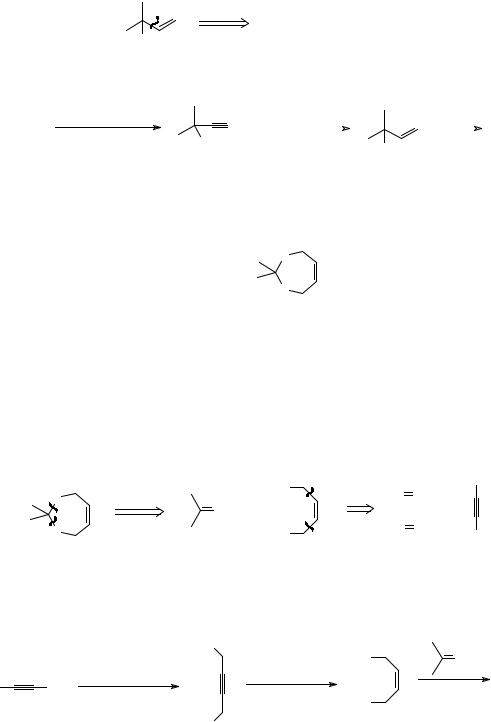
13
33. Analysis: you could make 32B by using a vinyl Grignard reagent and formaldehyde but it is easier to go via 32C and use the acetylide ion (frames 14-15) as a reagent for the synthon -CH=CH2:
 O + -CH
O + -CH CH2
CH2
OH
Synthesis: partial reduction of the acetylene gives the olefin:
|
|
1. Na, liquid NH3 |
|
H2 |
- Pd - C |
|
HBr |
|
HC |
|
CH |
|
|
|
|
|
TM 31 |
|
|
|
|
|||||
|
|
|
BaSO4 |
|
||||
|
|
2. acetone |
OH |
OH |
||||
|
|
|
poisoned catalyst |
|||||
|
|
|
|
|
|
|||
_______________________________________
34. Review Problem 3: This odd-looking molecule (TM 34) was used by Corey as an intermediate in the synthesis of maytansine, an antitumour compound.
O
TM 34
O
How would you make it? Don't be deceived by its oddness - identify the functional group and you will see what to do first.
_______________________________________
35. Analysis: the functional group is an acetal derived from alcohols and a carbonyl compound.
The diol must have a cis double bond so we can use the acetylene trick again here.
|
|
|
HO |
O |
CH2 |
|
H |
|
O |
FGI |
|
|
|||
|
+ |
+ |
|
||||
|
|
O |
O |
CH2 |
|
||
|
O |
|
HO |
|
H |
||
|
|
|
|
|
|||
Synthesis (Tetrahedron Letters, 1975, 2643): |
|
|
|
|
|||
|
|
HO |
|
HO |
|
|
|
|
|
|
|
|
O |
|
|
H |
H |
1. base, CH2O |
H2 - Pd - C |
|
|
H+ |
TM 34 |
|
|
|
|
||||
2. base, CH2O |
BaSO4 |
HO |
|
|
|||
HO
_______________________________________
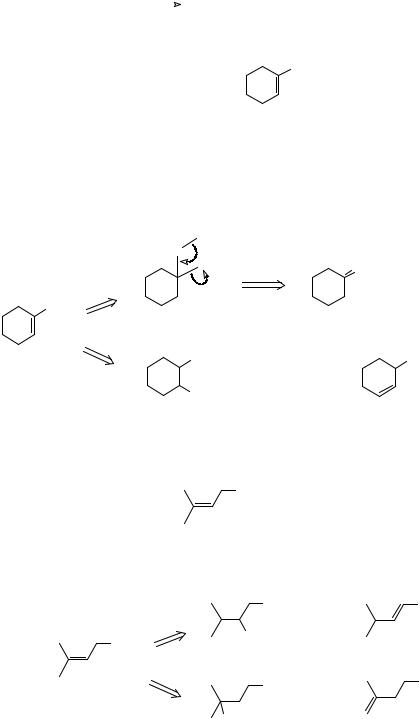
14
4.DISCONNECTIONS OF SIMPLE OLEFINS
36. Olefins are a little more complicated to analyse than alcohols. They can be made by the
dehydration of alcohols: |
+ |
|
|
|
|
||
|
|
|
H |
+ H2O |
|||
Me3C |
|
OH |
|
Me2C |
|
CH2 |
|
|
|
|
|||||
So the FGI stage in designing an olefin synthesis is to add water across the double bond. How would you synthesise TM 36? Ph
TM 36
_______________________________________
37. You should have two possible alcohols as the next step back, choosing one of these because it gives a useful disconnection while the other does not.
_______________________________________
38. Analysis: |
H |
|
|
O |
|
|
Ph |
O |
|
|
+ PhMgBr
Ph
A |
|
|
Ph |
no helpful |
Ph |
|
|
|
|
disconnection |
|
OH |
|
|
B |
|
C |
We must also consider whether the dehydration reaction might be ambiguous. Thus A can give only TM 36 on dehydration but B might give C as well. How would you make TM 38?
Ph
TM 38
_______________________________________
39. The alternatives are: |
|
|
Ph |
Ph |
|
|
|
||
|
|
|
A |
C |
|
Ph |
|
OH |
|
|
|
|
|
|
|
|
|
Ph |
Ph |
|
|
|
|
|
|
|
OH |
B |
D |
|
|
|
|
Dehydration of A could also give C, the conjugated olefin, but dehydration of B will give only TM 38 and none of the less substituted D. Now finish off the analysis and write out the synthesis.
_______________________________________
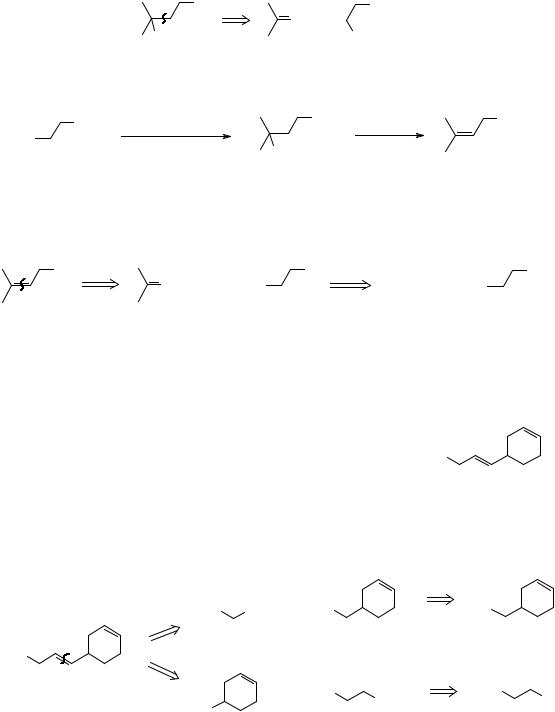
|
|
15 |
|
|
40. Analysis: |
Ph |
|
Ph |
|
|
O + |
|
||
B |
OH |
|
|
|
|
MgBr |
|
||
Synthesis: |
|
|
|
|
Ph |
1. Mg, Et2O |
Ph |
H3PO4 |
Ph |
Br |
2. Me2CO |
OH |
|
TM 38 |
(TM 26) |
|
|
||
|
|
|
|
_______________________________________
41. An alternative route to olefins is by an immediate disconnection of the double bond. This corresponds to the Wittig reaction:
Ph |
+ |
+ |
Ph |
Ph3P + |
Ph |
O |
Ph3P |
|
Br |
If you are unfamiliar with the Wittig reaction see Norman p.297-299 or Tedder, Part 3, p.233-6.
The advantages of this route are that it is very short and that the double bond must go where we want it. Otherwise it is very like the route in frame 40 and actually uses the same starting materials. How might you make TM 41?
TM 41 |
Ph |
_______________________________________
42. Choosing to disconnect the double bond outside the ring, as this will give us two fragments:
|
|
Ph CHO |
+ |
+ |
|
Br |
|
A |
Ph3P |
|
|||
|
|
|
|
|
|
|
Ph |
|
Wittig |
|
|
|
|
|
|
|
|
|
|
|
|
B |
|
+ |
Ph |
+ |
Ph |
|
|
|
||||
|
|
OHC |
|
|
PPh3 |
Br |
|
|
|
|
|
|
The starting materials for route B are recognisable as the halide we used in frame 41 and an aldehyde easily made by a Diels-Alder reaction. The other route could also be used but the starting materials are not so readily available. Write out the complete synthesis.
_______________________________________
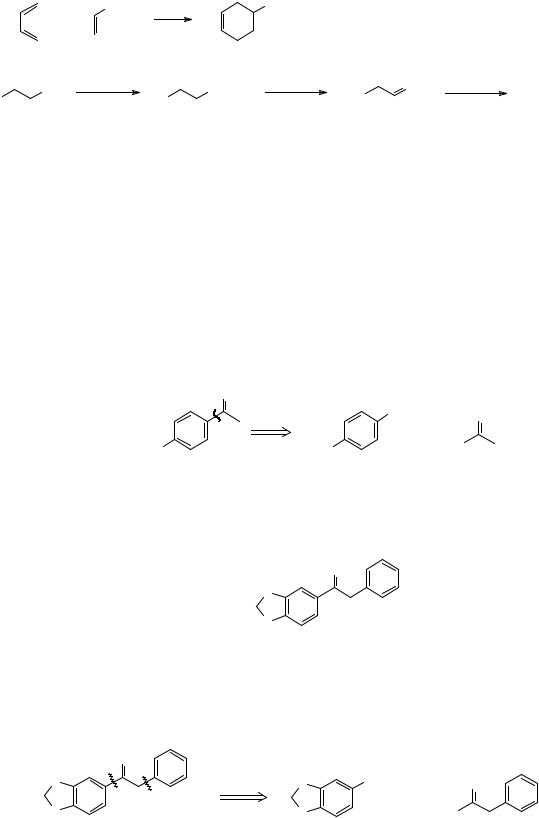
16
43.
|
|
CHO |
|
CHO |
|
|
|
|
|
+ |
|
|
|
|
|
|
Br |
PPh3 |
+ |
base |
PPh3 |
A |
TM 41 |
Ph |
Ph |
PPh3 |
|
|
|||
|
|
|
Ph |
|
|
This is a good opportunity to mention our third criterion for a good disconnection - that it leads to recognisable starting materials. We have used this criterion already in frames 20 and 42.
_______________________________________
5. DISCONNECTIONS OF ARYL KETONES
44. The Wittig reaction is important enough to be our second major one group disconnection. The first was the disconnection of alcohols to carbonyl compounds and Grignard reagents. Our third major one disconnects the bond joining an aromatic ring to an aliphatic side chain. So we would make TM 44 by the Friedel-Crafts reaction using acetyl chloride and aluminium chloride to attack the benzene ring:
|
O |
|
TM 44 |
H |
O |
|
|
+ |
MeO |
MeO |
Cl |
|
_______________________________________
45. In principle we can disconnect any bond next to an aromatic ring in this way, though not always in practice. How would you make TM 45?
O
O
TM 45
O
_______________________________________
46. One of the two possible disconnections a is better as it gives us an acyl rather than an alkyl halide and an activated benzene ring.
O |
a O |
|
H |
|
a |
O |
O |
||
|
b |
|
|
+ |
O |
|
|
|
|
|
O |
|
Cl |
If you're not sure about why this is so, or don't understand the mechanism of the FriedelCrafts reaction, you will find help in Tedder, part 2, pages 212-215 or Norman, pages 363370.
_______________________________________
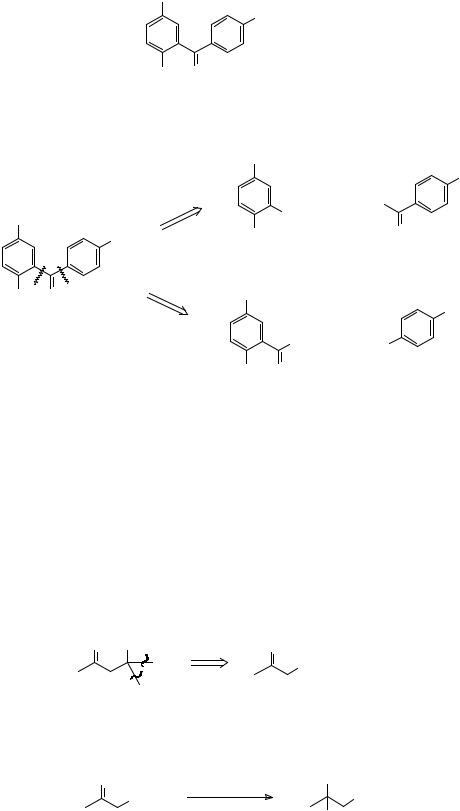
17
47. Sometimes a choice between two disconnections of this sort can be made by our first criterion (a good mechanism). How would you make TM 47?
Me
NO2
TM 47
MeO O
_______________________________________
48. There are two possible disconnections:
Me
NO2
|
|
a |
H |
Me |
|
|
|
|
|
MeO |
|
|
|
NO2 |
|
|
|
|
|
MeO a O |
b |
b |
Me |
|
Cl
MeO O
+
+
Cl
O
NO2
H
Disconnection b will not do as the nitro group is meta-directing and in any case nitro benzene will not react under Friedel-Crafts conditions. Disconnection a is fine as the MeO group is more powerfully ortho-directing than the Me group (Ber., 1907, 40, 3514).
_______________________________________
6. CONTROL
49. Before we complete the disconnections of carbonyl compounds we shall look at some aspects of control in synthesis as a break from the systematic analysis.
Why might the obvious disconnection on TM 49 give trouble when the real reaction is tried?
O OH |
O |
+ 2PhMgBr |
Ph |
CO2Et |
|
TM 49 |
|
|
Ph |
|
|
_______________________________________
50. The Grignard reagent might first attack the ketone giving the wrong product.
O |
PhMgBr |
OH |
|
CO2Et |
CO2Et |
||
|
|||
|
|
Ph |
To stop this we protect the ketone by a reversible FGI. A common method is to make the cyclic ketal:
